Restoring a Classic Spectrum Analyzer Part 1 - Finding a Unit
25/03/13 17:34
For many years, the gold standard of performance, quality, and reliability for spectrum analyzers was the HP 8568/8566. Its performance was exceptional when introduced in 1978 and continued to set the bar for precision spectrum measurements for many years to come. It introduced new functions never seen before in a spectrum analyzer such as marker peak search, marker centre frequency, etc. which I can’t imagine not having today. Beyond its performance and features, the HP 8566 was a durable and robust piece of test equipment. Its chassis, although heavy, was a rugged and extremely well engineered unit. I have a soft spot for these “vintage” test instruments from this era. It is obvious to me that HP really cared about building very high quality test instruments which would enjoy very long service lives. They were built by engineers, for engineers. A testament to this fact is the wide availability of HP 8566 units still available today on eBay and other sources–more than 30 years since it was introduced. (A great resource for HP history, and for history on the HP8568/66 can be found at the excellent HP Memory Project website)
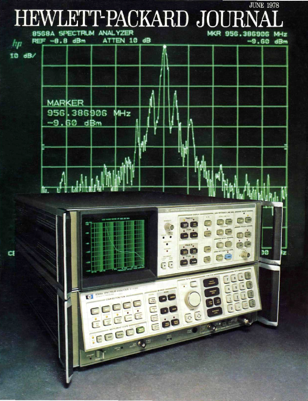
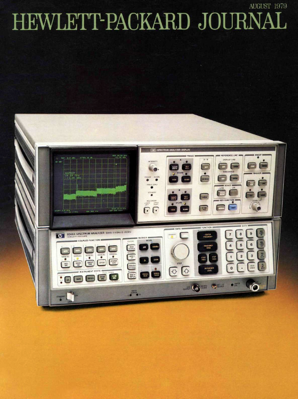
The successor to the HP 8566 was to become HP 70000 series of modular instruments. HP took a very different design approach to build their next generation of high performance analyzers. Instead of building independent instrument products such as a stand-alone spectrum analyzer or microwave analyzer, HP decided to introduce the concept of the “modular measurement system” (MMS for short). This concept was based on the idea of providing one or more chassis with common power supply and control bus. These chassis would be populated with functional module building blocks, such as tuners, IF sections, local oscillators, etc. to build whatever instrument(s) are required. This concept is not unlike other modular electronic form factors such as VME, VXI, CompactPCI, PXI, etc. This MMS system was called the 70000 series of modular instrument modules and test instruments. Another advantage of this modular instrument concept was for customers who built advanced ATE (automated test equipment) systems for production line test and calibration. Instead of populating a large 19” rack full of discrete instruments, customers could populate one or two 70000 mainframes with multiple instruments. This simplifies system interconnect, configuration, and integration with ATE software as well as occupying much less physical space.
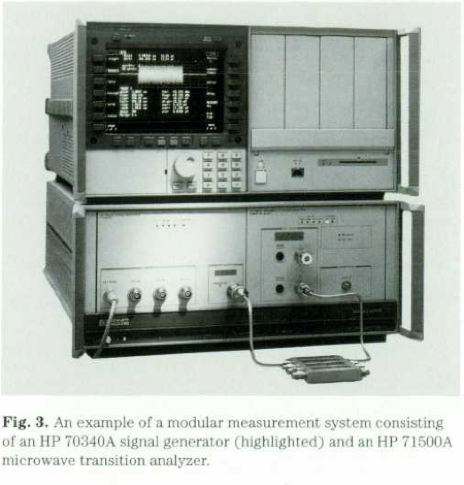
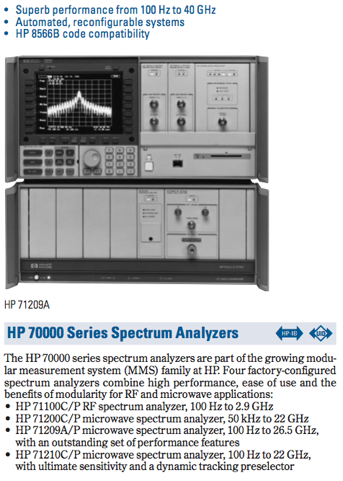
For me, the 70000 MMS instruments represent the last of the “great” HP instrument designs before transforming into Agilent and progressively adopting a different low-cost driven design approach. Also, I must admit, I have warm nostalgia for the 70000 instruments. During my university years in engineering and graduate school, I heavily used the HP 70000 microwave and lightwave spectrum analyzers as well as the Gb/s bit error rate (BER) test sets. As well as being an RF engineer, I also love writing software. Therefore, the modular design of these instruments had great appeal to me since it was analogous to the modular design patterns we use for software development. Also, it was clear to me that same care and attention to detail was spent in designing a robust and elegant instrument.
In support of my consulting and development work at Vectis Research, I have happily used my HP 8595A spectrum analyzer–another great HP instrument–reliable, easy to use, and high performance. However, there were many times when I just needed that extra resolution bandwidth below 300 Hz or frequency coverage beyond 6.5 GHz. I had initially intended on purchasing a surplus HP 8566 since I knew I could find a unit in excellent condition at a reasonable price. However, I was always tempted by the allure of the 70000! Finding a 70000 based spectrum analyzer was never going to be easy. You could either find a pre-populated instrument configuration as follows:
HP 71100C RF spectrum analyzer, 100 Hz to 2.9 GHz
HP 71200C microwave spectrum analyzer, 50 kHz to 22 GHz
HP 71209A microwave spectrum analyzer, 100 Hz to 26.5 GHz
HP 71210C microwave spectrum analyzer, 100 Hz to 22 GHz
Alternatively, you could build up a system gradually by individually purchasing the mainframe and all of the required MMS modules to make a spectrum analyzer. Pre-populated instrument configurations appear very rarely as surplus, since most test instrument vendors/re-sellers get more value by selling the 70000 modules individually. Building an instrument by purchasing individual modules requires a great deal of research in the beginning. You have to know the module configuration required to make a spectrum analyzer, nuances of module versions and compatibility, interconnecting cables, and controller software/firmware compatibility. Also, when buying modules individually, you have to consider the cost overhead for shipping/customs applied to each module transaction–this can easily make this approach cost prohibitive.
I had roughly established that I wanted the following configuration:
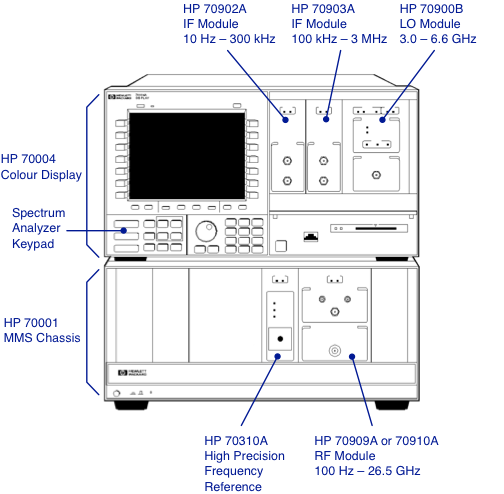
A few points to note:
1) I really preferred to have the 70004 colour display rather than the 70205A monochrome graphics display.
2) I had to make sure the 70004 display came with the spectrum analyzer keypad installed. You could get a display with no user keypad and still be able to use the instrument via soft keys; however, it is much better to have the dedicated keys for frequency, span, reference level, etc.
3) Based on what I had read in forums, it was worth trying to get the 70900B version of the LO module rather than the older 70900A. The firmware was much better and supported more configurations with other modules. It was also claimed that the LO phase noise was also better.
4) I wanted to get an RF module which had an integrated tracking pre-selector front-end. That meant either the 70909A or 70910A; the 70910A has a selectable bypass for the pre-selector which the 70909A does not.
Luckily, I remained patient, and continued to search eBay and other sources and began to establish a sense of market price level for each MMS module. Also, I continued to learn as much as I could technically about the 70000 MMS family from internet forums, research, and old catalogs. The more I learned, the more I continued to desire a 70000 based spectrum analyzer! Then, in Feb 2013 serendipity struck–I found a configured 70000 series spectrum analyzer from a Canadian seller! This made a huge difference since shipping and customs was always going to be a huge cost factor when acquiring modules from the US (the largest source).
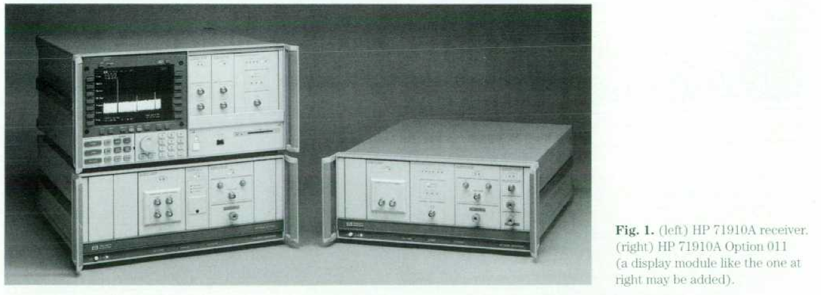
The instrument listing appeared to show a somewhat modified version of the 71209A, i.e. it had the 70910A RF module (26.5 GHz) but was missing the 70903A IF module (100 kHz to 3 MHz IF). However, I was very excited to see that it had two very nice options: a 70310A precision frequency reference and a very rare 70911A IF module (10 MHz – 100 MHz with all options for 70 MHz IF output, video & FM outputs, and I/Q outputs). The 70911A module and its firmware add a new user software “personality” for a wideband surveillance receiver. Thus, you not only have a spectrum analyzer instrument, but a wideband receiver too! I didn’t waste much time, I asked the vendor a few questions to clarify the history and condition of the unit and after I was satisfied, I purchased the unit!
In my next article, I will describe the anxious process of receiving the spectrum analyzer, verifying its operating status and condition, and planning for its refurbishment.
Related Articles
A Microwave Receiver for Wide-Bandwidth Signals, HP Journal Oct. 1995
HP 71100A 2.9 GHz Spectrum Analyzer, www.prc68.com


The successor to the HP 8566 was to become HP 70000 series of modular instruments. HP took a very different design approach to build their next generation of high performance analyzers. Instead of building independent instrument products such as a stand-alone spectrum analyzer or microwave analyzer, HP decided to introduce the concept of the “modular measurement system” (MMS for short). This concept was based on the idea of providing one or more chassis with common power supply and control bus. These chassis would be populated with functional module building blocks, such as tuners, IF sections, local oscillators, etc. to build whatever instrument(s) are required. This concept is not unlike other modular electronic form factors such as VME, VXI, CompactPCI, PXI, etc. This MMS system was called the 70000 series of modular instrument modules and test instruments. Another advantage of this modular instrument concept was for customers who built advanced ATE (automated test equipment) systems for production line test and calibration. Instead of populating a large 19” rack full of discrete instruments, customers could populate one or two 70000 mainframes with multiple instruments. This simplifies system interconnect, configuration, and integration with ATE software as well as occupying much less physical space.


For me, the 70000 MMS instruments represent the last of the “great” HP instrument designs before transforming into Agilent and progressively adopting a different low-cost driven design approach. Also, I must admit, I have warm nostalgia for the 70000 instruments. During my university years in engineering and graduate school, I heavily used the HP 70000 microwave and lightwave spectrum analyzers as well as the Gb/s bit error rate (BER) test sets. As well as being an RF engineer, I also love writing software. Therefore, the modular design of these instruments had great appeal to me since it was analogous to the modular design patterns we use for software development. Also, it was clear to me that same care and attention to detail was spent in designing a robust and elegant instrument.
In support of my consulting and development work at Vectis Research, I have happily used my HP 8595A spectrum analyzer–another great HP instrument–reliable, easy to use, and high performance. However, there were many times when I just needed that extra resolution bandwidth below 300 Hz or frequency coverage beyond 6.5 GHz. I had initially intended on purchasing a surplus HP 8566 since I knew I could find a unit in excellent condition at a reasonable price. However, I was always tempted by the allure of the 70000! Finding a 70000 based spectrum analyzer was never going to be easy. You could either find a pre-populated instrument configuration as follows:
HP 71100C RF spectrum analyzer, 100 Hz to 2.9 GHz
HP 71200C microwave spectrum analyzer, 50 kHz to 22 GHz
HP 71209A microwave spectrum analyzer, 100 Hz to 26.5 GHz
HP 71210C microwave spectrum analyzer, 100 Hz to 22 GHz
Alternatively, you could build up a system gradually by individually purchasing the mainframe and all of the required MMS modules to make a spectrum analyzer. Pre-populated instrument configurations appear very rarely as surplus, since most test instrument vendors/re-sellers get more value by selling the 70000 modules individually. Building an instrument by purchasing individual modules requires a great deal of research in the beginning. You have to know the module configuration required to make a spectrum analyzer, nuances of module versions and compatibility, interconnecting cables, and controller software/firmware compatibility. Also, when buying modules individually, you have to consider the cost overhead for shipping/customs applied to each module transaction–this can easily make this approach cost prohibitive.
I had roughly established that I wanted the following configuration:

A few points to note:
1) I really preferred to have the 70004 colour display rather than the 70205A monochrome graphics display.
2) I had to make sure the 70004 display came with the spectrum analyzer keypad installed. You could get a display with no user keypad and still be able to use the instrument via soft keys; however, it is much better to have the dedicated keys for frequency, span, reference level, etc.
3) Based on what I had read in forums, it was worth trying to get the 70900B version of the LO module rather than the older 70900A. The firmware was much better and supported more configurations with other modules. It was also claimed that the LO phase noise was also better.
4) I wanted to get an RF module which had an integrated tracking pre-selector front-end. That meant either the 70909A or 70910A; the 70910A has a selectable bypass for the pre-selector which the 70909A does not.
Luckily, I remained patient, and continued to search eBay and other sources and began to establish a sense of market price level for each MMS module. Also, I continued to learn as much as I could technically about the 70000 MMS family from internet forums, research, and old catalogs. The more I learned, the more I continued to desire a 70000 based spectrum analyzer! Then, in Feb 2013 serendipity struck–I found a configured 70000 series spectrum analyzer from a Canadian seller! This made a huge difference since shipping and customs was always going to be a huge cost factor when acquiring modules from the US (the largest source).

The instrument listing appeared to show a somewhat modified version of the 71209A, i.e. it had the 70910A RF module (26.5 GHz) but was missing the 70903A IF module (100 kHz to 3 MHz IF). However, I was very excited to see that it had two very nice options: a 70310A precision frequency reference and a very rare 70911A IF module (10 MHz – 100 MHz with all options for 70 MHz IF output, video & FM outputs, and I/Q outputs). The 70911A module and its firmware add a new user software “personality” for a wideband surveillance receiver. Thus, you not only have a spectrum analyzer instrument, but a wideband receiver too! I didn’t waste much time, I asked the vendor a few questions to clarify the history and condition of the unit and after I was satisfied, I purchased the unit!
In my next article, I will describe the anxious process of receiving the spectrum analyzer, verifying its operating status and condition, and planning for its refurbishment.
Related Articles
A Microwave Receiver for Wide-Bandwidth Signals, HP Journal Oct. 1995
HP 71100A 2.9 GHz Spectrum Analyzer, www.prc68.com